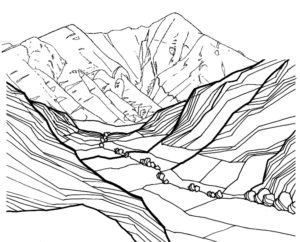The Thought: Indigenous people of the Pacific Islands managed tough conditions to create working, symbiotic, reciprocal agriculture and aquaculture. The techniques and approaches differ greatly between island nations, and while most of these practices were ended for more industrialized agriculture, some nations are preserving and returning to the former relationships they had with their islands.
In Hawaii, the ahupua’a is a strong example of understanding the relationship between agriculture and microclimates. In Tonga, traditional slash and burn practices are another example of how people used a sustainable system to manage food production
Objectives:
- Identify and describe two different farming techniques used by indigenous pacific islanders
- Choose and identify one example of farming and describe its benefit to the environment.
- Explain the difference between sustainable agricultural practices and industrial agriculture.
Timeframe:
2- 10 minute thinking routine activities
(don’t forget to use the rope-tying activity to emphasize progress in learning)
30-60 minute art/science project on second day
Multi-month gardening activity for different grades
Materials:
Modeling clay
Poster paint
Colored markers or crayons
Poster Board
Masking Tape
Various shaped small cookie cutters (optional)
Plant and animal shaped stencils (optional)
Vocabulary:
Ahupua’a
Ali’i
Applies
Deforestation
Ecosystem
Industrial Agriculture
Invasive Species
Invasive Species
Slash and Burn
Staple Foods
Sustainable
Teacher Preparation:
Follow this link to a “bookcase” of PDFs. Each comes directly from separate websites that may have additional resources for you or your students.
Activities and Readings
Activity 1: Slash and Burn (Thinking Routine: I Used to Think…)
- Ask students what they think of when they hear the phraseslash and burn. Record their responses on the chalkboard or white board. Let them know that they will be looking at those responses again at the end of the activity.
- Give the class two different definitions of slash and burn.
- Present them with two different kinds of slash and burn practices from the readings. 3-5 grades will be better suited to reading and comprehension of some of these documents. Others are simply for teacher preparation.
- Pass out copies of the pie chart to the right, ask the students to color one of the pie slices one color and the remaining pie pieces a different color. Explain to them the traditional process of slash and burn in Tonga (based on the teacher readings), namely that each pie piece is farmed for only 2 years at a time and that it takes 14 years before the first pie piece is farmed again.
- Show the students the image of slash and burn industrial agriculture in the Amazon rainforest. Ask them to compare the Tongan model to this one. Record their responses in a second column on the blackboard or whiteboard.
- Ask students to compare their responses.
- Ask the students to answer the initial question again: what do they think of when they hear the phraseslash and burn and have them complete the thinking routine.
Activity 2: Ahupua’a (Thinking Routine: Think, Pair, Share)
- Share the photo of an ahupua’a with your class. Ask them to identify the places where crops are growing, where people are living, where they see the sources of water.
- Have students think about what vegetables and fruits they would want to grow in their own ahupua’a. Do they eat meat? Fish? Where would they like to live — on the beach like royalty, or in the quiet of the forest?
- Have them turn to a classmate and share their thoughts and then prepare them for the art activity.
Art Activity
Asking students to construct their own ahupua’a may sound strange. However, by placing themselves at the helm of creating a sustainable system lends to the idea that agricultural practices are bound by trial and error, experimentation, adaptation and scientific reasoning.

Adaptation for K-1st grade
- Using the coloring page to the right ask the students to color in the ahupua’a by deciding where they want to plant their favorite fruits and vegetables, catch their fish, and where to place their family and house. Ask them to draw where the river will flow from the top of the mountains down into the famrlands.
- Have the students share their pictures with a different classmate. In Hawaii the ali’i, or royalty, would oversee their own ahupua’a, while right next door, another ali’i
Adaptation for 2nd – 3rd grades
- Using modeling clay, students will create their own ahupua’a. Students should follow the same instructions as the K-1st
Activity 3: For Everyone
Grow your own classroom Ti or Taro plant in a bucket.
How to Grow Wetland Taro in Buckets
